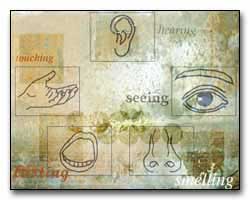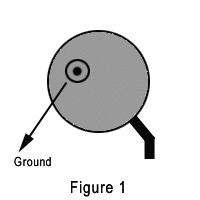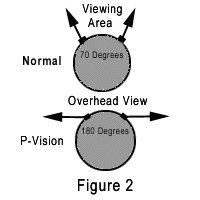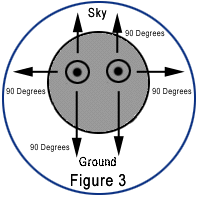|
Unfortunately, most modern day people walk through nature with their heads slightly tilted downward and their eyes looking at the ground (Figure 1). Are they afraid of tripping over a stone, or slipping on some leaves,
 or touching poison ivy or is it just a habit and they don't even realize that they are even looking that
way? Unfortunately, great nature opportunities are missed when the eyes are continuously looking at the ground. FACT: You will not trip or fall any more than normal if your eyes are looking ahead versus constantly looking at the ground.
or touching poison ivy or is it just a habit and they don't even realize that they are even looking that
way? Unfortunately, great nature opportunities are missed when the eyes are continuously looking at the ground. FACT: You will not trip or fall any more than normal if your eyes are looking ahead versus constantly looking at the ground.
Another trap in the art of seeing is tunnel vision. How many times have you said, "I don't even remember driving to work?" You've traveled that road so very often that your mind and sight tunes out and the driving experience does not even register. Your mind has given you the message of "I have driven this route so many times that there really is nothing to see any more on this route. So why bother to pay attention." Do you realize how much is missed when you even take a walk around the neighborhood? A walk that you have taken numerous times. There is so much going on in nature every time you take that first step out of your house. FACT: You will have numerous nature opportunities each time you take a
 step out of your house. You already have certain moments when you use your Outdoor Eyes... you just
have to learn how to use your Outdoor Eyes all the time. The art of seeing is not difficult and at certain moments you've already seen with Outdoor Eyes without even knowing.
step out of your house. You already have certain moments when you use your Outdoor Eyes... you just
have to learn how to use your Outdoor Eyes all the time. The art of seeing is not difficult and at certain moments you've already seen with Outdoor Eyes without even knowing.
The final trap is trying too hard or having too much anticipation. Learn how to enjoy the moment of being in nature. Don't try to see something that really isn't there and don't get caught up in believing that every time you venture outside, a great moment will be waiting just around the corner. When you don't try too hard or anticipate too much, great nature opportunities will appear.
The Art Of Seeing - Peripheral Vision (P-Vision):
 P-Vision is the ability to see in multiple directions at the same time. With normal vision, you're usually only seeing within an area of approximately 70 degrees from side to side and 70 degrees from top to bottom. You're usually focusing on one central object at a time (Figure 2 top showing an overhead view of the head). With P-Vision, you learn to see an area of approximately 180 degrees from side to side and 180 degrees from top to bottom. (Figure 2 bottom). If this is the way that you usually view nature (staring ahead and concentrating on one object), just think of all the nature opportunities you've been missing.
P-Vision is the ability to see in multiple directions at the same time. With normal vision, you're usually only seeing within an area of approximately 70 degrees from side to side and 70 degrees from top to bottom. You're usually focusing on one central object at a time (Figure 2 top showing an overhead view of the head). With P-Vision, you learn to see an area of approximately 180 degrees from side to side and 180 degrees from top to bottom. (Figure 2 bottom). If this is the way that you usually view nature (staring ahead and concentrating on one object), just think of all the nature opportunities you've been missing.
How To Use P-Vision:
Instead of focusing on a single object, stare your eyes straight ahead to the horizon using a restful vision. A restful vision is vision that is somewhat out of focus (a little blurry) since you are not focusing on one particular object. Take this simple test. Stare straight ahead focusing on one object. Raise your arms out to the side of your body so they are parallel to the ground, perpendicular to  your body and palms facing outward. Slowly bring the arms forward while you are moving your fingers. At some point you will be able to see both hands moving. As soon as one hand is noticed, stop moving that arm forward and continue to move the other arm forward until the other hand is noticed. Note what angle was formed by the two arms. Now, try to look forward at the horizon without focusing on a single object. Look with the restful vision of P-Vision (somewhat out of focus). Repeat the same arm motion from your sides. Notice the new angle of the two arms when you see each hand moving. If you have maximized the use of P-Vision, the two arms will be in alignment with each other and the angle will be almost 180 degrees. Try to repeat the test again with one arm positioned above your head and the other arm positioned below extending to the ground. Figure 3 shows a front view of the head using P-Vision.
your body and palms facing outward. Slowly bring the arms forward while you are moving your fingers. At some point you will be able to see both hands moving. As soon as one hand is noticed, stop moving that arm forward and continue to move the other arm forward until the other hand is noticed. Note what angle was formed by the two arms. Now, try to look forward at the horizon without focusing on a single object. Look with the restful vision of P-Vision (somewhat out of focus). Repeat the same arm motion from your sides. Notice the new angle of the two arms when you see each hand moving. If you have maximized the use of P-Vision, the two arms will be in alignment with each other and the angle will be almost 180 degrees. Try to repeat the test again with one arm positioned above your head and the other arm positioned below extending to the ground. Figure 3 shows a front view of the head using P-Vision.
Another way to practice P-Vision is while driving your car or walking. Notice how soon you can see a car passing you on the left and sometimes unfortunately on the right. The same applies when you're walking. Notice when someone walks by you either on the left or right.
Just as important is the 180 degrees up and down using P-Vision. Using P-Vision, at first you'll see more squirrels moving in the upper trees. Then, you will see more hawks flying above. Your P-Vision captures the hawk's movement and when you quickly look above in focus, you will see a Red-Tailed Hawk circling.
The purpose of P-Vision is to make you aware of any motion that occurs within your expanded field of view - up, down, left and right. If you aware of motion, you won't miss any nature opportunities. Once motion is seen, quickly turn your head towards the direction of the motion and focus on the object. When you become very efficient with using P-Vision, you will even be able to identify what wildlife is moving without focusing in that direction. Another purpose of P-Vision is to potentially stop the alarm call of the birds (see the language of the birds section). If you are able to see the song birds, you will stop your forward motion in time before the song birds start their alarm calls. By stopping, you will not interfere with any wildlife nearby in baseline and more nature opportunities will appear.
Click One Of The Five Senses Below To Continue.
The Five Senses
The Art Of Hearing
The Art Of Touching
The Art Of Smelling
The Art Of Tasting
| 
